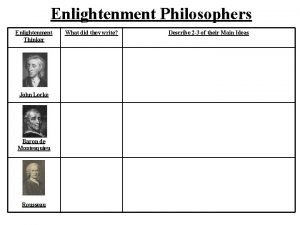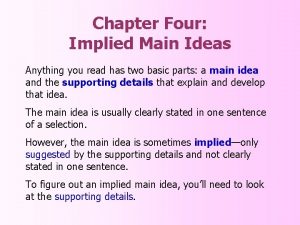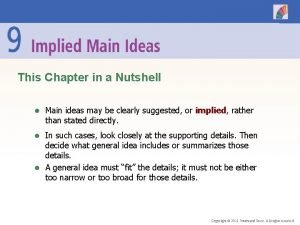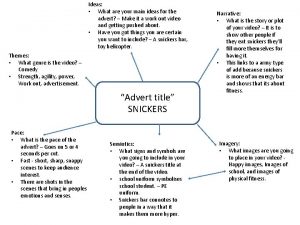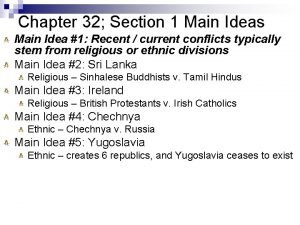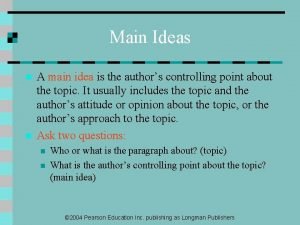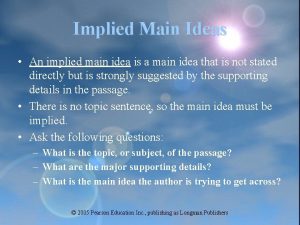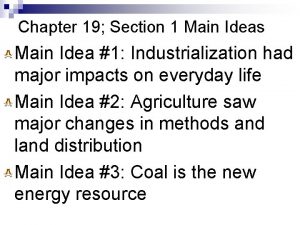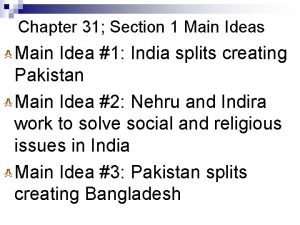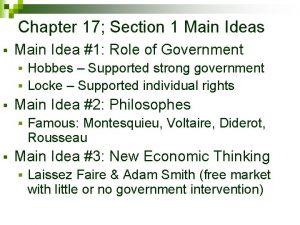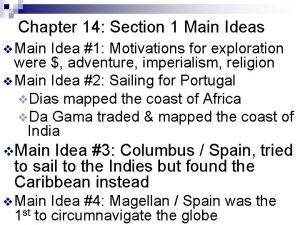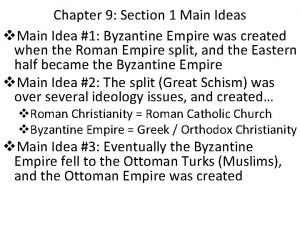Energy Energy Main Ideas l l Energy is



















- Slides: 19

Energy

Energy: Main Ideas l l Energy is the ability to do work. The law of conservation of energy says that energy can be neither created nor destroyed. Energy can change from one form to another, but total energy always remains unchanged. Work and energy are closely related. When work is done on a system, the system gains potential or kinetic energy. When a system has energy, that energy can be used to do work. Units of energy and work are the same. l l SI = Newton Meters or Joules English = foot-pounds.

Potential vs. Kinetic Energy Potential Energy = Stored Energy Kinetic Energy = Energy in motion If a force changes and object’s vertical position on earth, the object is given potential energy. Gravitational potential energy is the energy gained because of a change in an object’s vertical position. An unbalanced force changes and object’s motion and causes an increase or decrease in it’s speed. Kinetic energy is the energy something has because of it’s speed. In many systems, energy changes back and forth between potential and kinetic energy. If there is resistance, some kinetic energy is changed to heat energy.

Total Energy-swinging pendulum Total Energy = Potential + Kinetic Energy

Newton’s First Law (Law of Inertia): Every object will remain at rest, or will continue to move in a straight line with constant speed, unless the object is acted on by a non-zero net force. Inertia: The property of an object to resist changes in it’s motion (an objects mass tells you how much inertia that it has).

Energy: Mechanical & Fluid

Potential Energy (Mechanical and Fluid) : Main Ideas l If an object of weight (w) is raised a vertical distance (h), the gravitational potential energy (Ep ) is equal to w * h. l Elastic potential energy equals the work done to stretch or compress elastic objects such as springs.

Energy (Mechanical and Fluid): Main Ideas Continued Energy = Ability to work Potential Energy Ep = wh (English) Ep = mgh (SI) Kinetic Energy Ek = ½ mv 2 Ek = ½ Iω2 Note: (wh) = (mgh) or Nm = kg*m*m/sec 2 Therefore Nm = kg *m 2/sec 2 = J Fluid Ep = weight x height (Eng) Ep = mgh (SI) * m = ρ * v * Weight = ρw * V ρw = 62. 416 lbs/ft 3 ρ = density = 1000 kg/m 3

Potential Energy Problems W = ____lbs W = ____N h = ____ft h = ____m Student X has just finished climbing to the top of a tower to drop water balloons on unsuspecting passersby. If Student X has weight of 205 lbs (including water balloons) and the tower has a height of 40 ft how much Gravitational Potential Energy-in Joules-was added to this system? ? ? W = _____ J

Elastic Potential Energy Springs have a constant (k) which indicates how flexible (stiff) the spring is. This constant can be found using the fomula: k = f/d k = spring constant f = force required to stretch or compress the srping d = distance the spring is displaced After you know the spring constant (k), you can then calculate the elastic potential energy using the formula:

Elastic Examples (cont. )

Kinetic Energy Problems Kinetic Energy is mass in motion (Ek = ½ mv 2) Two Foot-ball players crash into each other during a game. Player A is the water boy who has a mass of 50 kg (110 lbs or 490 N) but is running at a speed of 4 m/sec. This player runs directly in to Player B who is the defensive tackle that has a mass of 100 kg (220 lbs or 980 N) and is moving at 2 m/sec. l Who has the greatest kinetic energy when they crash? If you are playing baseball, is it better to use a bat twice as big as normal, or to swing the bat two times faster than normal?

Kinetic Examples (cont. ) Given: (Ek=1/2 mv 2) A wrecking ball that weighs one ton moves with a speed of 30 ft/sec just before it slams into the side of a building. note: acceleration due to gravity is 32 ft/s 2 Find: Kinetic energy of wrecking ball when it hits the wall

Potential Energy in a Fluid System When a water pump lifts water from a reservoir to a water tower, the work done is changed to potential energy. The formula used to calculate this fluid potential energy is the same as the formula for mechanical.

Kinetic Energy of Fluids

Newton’s First Law (Law of Inertia): Every object will remain at rest, or will continue to move in a straight line with constant speed, unless the object is acted on by a net force. Inertia: The property of an object to resist changes in it’s motion (an objects mass tells you how much inertia that it has).

Moment of Inertia (Spinning Mass): A property that describes an objects resistance to change in rotational motion. The moment of inertia is determined by: 1. Location of Axis 2. Mass 3. How the mass is distributed

Moment of inertia continued

Rotational kinetic energy
 Ideas have consequences bad ideas have victims
Ideas have consequences bad ideas have victims Los deseos ridículos preguntas y respuestas
Los deseos ridículos preguntas y respuestas Candide
Candide Voltaire and john locke
Voltaire and john locke Voltaire main ideas
Voltaire main ideas Big ideas
Big ideas Voltaire main ideas
Voltaire main ideas Christianity main ideas
Christianity main ideas Enlightenment philosophers chart
Enlightenment philosophers chart A key intellectual movement of the renaissance
A key intellectual movement of the renaissance Kant philosophy
Kant philosophy Hume's fork examples
Hume's fork examples Stated main idea
Stated main idea Implied main ideas
Implied main ideas What is the implied main idea of the passage
What is the implied main idea of the passage Characteristics of existentialism
Characteristics of existentialism Main ideas definition
Main ideas definition Townsend press chapter 4 implied main ideas
Townsend press chapter 4 implied main ideas Puritanism and individuality in the crucible
Puritanism and individuality in the crucible Will future
Will future








